Based on the sketches done by Dutch VW importer, Ben Pon in 1947, which in turn were based on a layout of the Plattenwagen (flattened car), a Beetle-based, mend-and-make-do Wolfsburg-factory transport designed by Major Ivan Hirst of the Royal Electrical and Mechanical Engineers, the first Type 2 (Beetle was Type 1), went on sale in 1950. Developing new vehicles was a lot speedier in those days.
In the ensuing 73 years, the microbus or ‘Bulli’ as it is known in Germany, whether as a Camper, pickup, bus, or van has become one of the most loved VWs ever built – the people’s van if you like. It’s become part of the myths which VW tells itself, it’s transported The Beach Boys, The Fabulous Furry Freak Brothers, The Who, and the Flower Power generation, and it was only in 2014 that new production of the second-generation ‘bay window’ version ceased in Brazil.

It’s been an itch which VW has found impossible not to scratch. All the way back to 1994 and the unveiling of Concept 1, which became the new Beetle, there were rumours of a new Type 2 on the cards. It wasn’t until 2001, however, that Volkswagen re-imagined its history with its Microbus concept presented at the wintery Detroit Auto Show. With its translucent rubber floors and plasma screens, combined with retro looks, the concept designed by Charles Ellwood at VW’s California design studios, carved a fine line between old and new. It was based on the mechanicals of the then-new front-engined T5 Transporter, but recalled the clattering, air-cooled campers and combis of yore. The reception was rapturous and the following year VW announced its imminent production, then promptly cancelled it.
VW kept its thumb on the tease-em button, however, with the 2011 Bulli, the 2016 Budd-e and the 2017 ID Buzz, which were shown variously as microbuses, combis, vans and campers, most of them standing not the slightest chance of production.
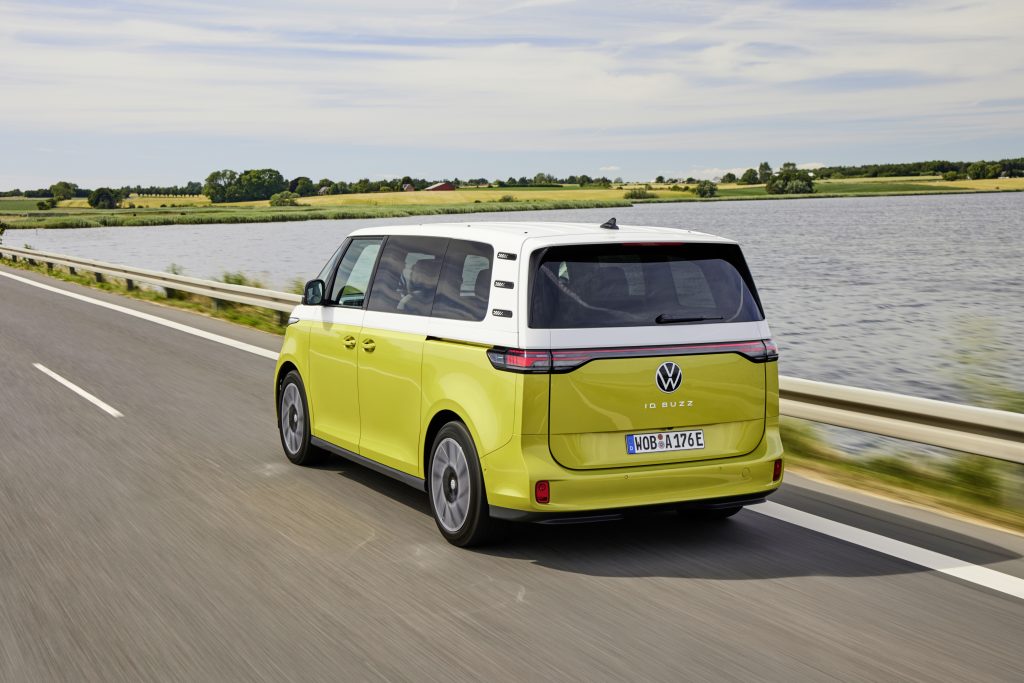
Perhaps we only get a couple of decent retro designs a decade; the nineties saw Porsche’s Boxster (1993) and Volkswagen’s Concept 1 (1994), the noughties saw Ford’s Mustang GT concept (2003) and Fiat’s Trepiùno (Cinquecento) concept (2004), there was the Alpine A110 in 2017 and the Mercedes G-class in 2018, and in this decade, we’ve seen Renault’s 5 Electric concept and Volkswagen ID Buzz, which is what I’m now sitting in, waiting to go. It’s been a long wait and even Jozef Kabaň, VW design director, says: “it’s a relief to be able to show this vehicle off”.
With prices starting at £57,115 on the road, the ID Buzz goes on sale this autumn with first deliveries early in the new year. Moving up the trim scale to the Style trim version will cost £61,915 and the launch 1st Edition version will cost £62,995. The Cargo van version starts as the Commerce version at £38,125 without VAT, and rises to the Commerce Plus with radar-and-camera-based safety and parking assistance at £42,375.
Note here that this is not the Camper, which is the version we most associate with the Type 2 in the UK. You can buy an optional through-floor mattress and ‘cuckoo box’, which is a sort of camp kitchen, but as it stands ID Buzz is a five-seater, and the van version has two or three seats. A seven-seat version will arrive next year and there’s also confirmation of four-wheel drive, larger batteries and a full Camper version on a longer wheelbase, which will mark the debut of the ID Buzz in America, but they’re all to come.
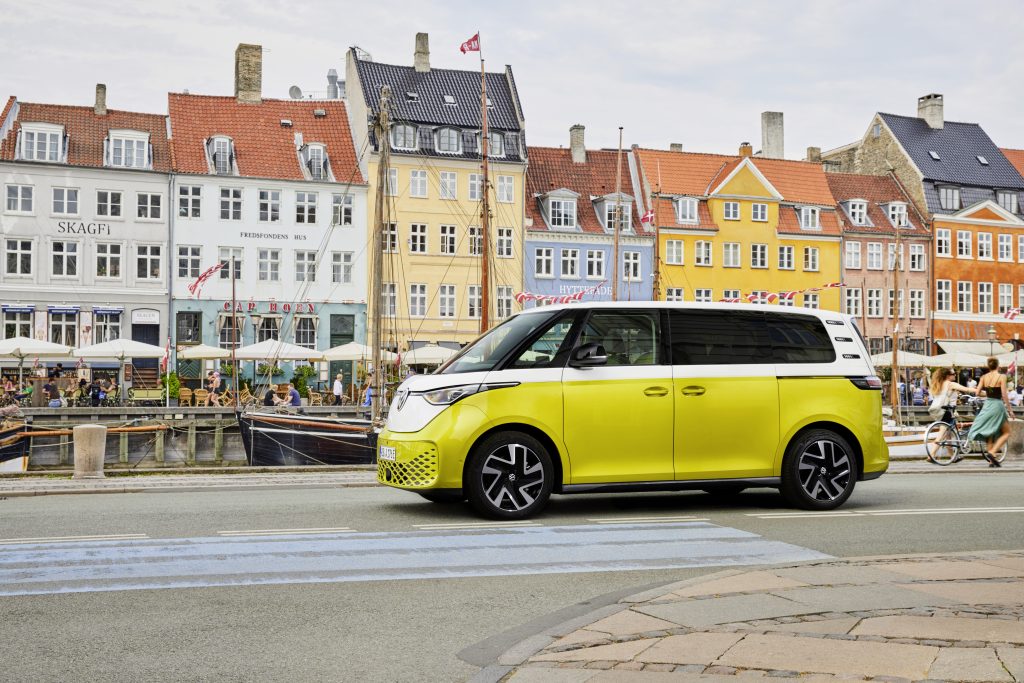
Yes, it’s expensive, but in a world where the traditional MPV is the fastest disappearing market segment, it’s hard not to think that VW has reinvented the sector. Rivals are scarce, but there’s the seven to nine-seat Mercedes-Benz EQV, which costs from £71,760 with a 90kWh battery giving a 211-mile range, or the Vauxhall Vivaro E-Life which costs from £34,645 and seats up to nine, with the 50kWh battery giving a range up to 143 miles. Compared to the ID Buzz, however, these have all the appeal of an airport courtesy bus.
Oh, and did I mention it looks fabulous? Treading that fine line between pastiche and reminiscence, it has its own character to boot. It’s big though. While the original 1950 Type 2 was 4280mm long, 1720mm wide and ran on a 2.4-metre wheelbase, this version is 4712mm long, 1985mm wide and has a 2988mm wheelbase.
Weighed down
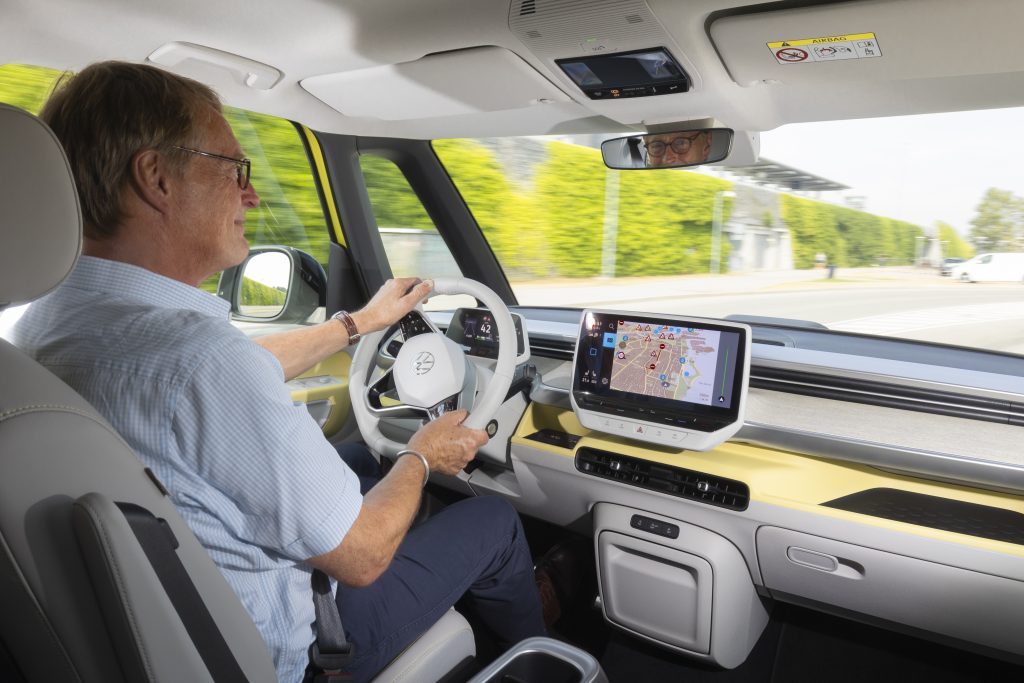
It’s also heavy, which in turn impacts how much it can carry. It is certified at a maximum of 3 tonnes, which means, with a kerb weight of 2.47 tonnes with a driver, you’ve only got 530kg as payload (the Cargo van gets a payload of 650kg). That’s not great, especially when you consider the original Type 2 had a payload of 750kg.
Fill all the seats with large adults and you’re left with a payload capacity of 190kg to sling into the massive 1,121 litres of load space. Fold the rear seats and you get 2,205 litres. VW also claims the commercial is exempt from the current regulations that restrict vans over 2040kg to 60mph on dual carriageways.
All of this might explain why VW restricted seating in the ID Buzz to five people. It will also tow up to one tonne and the Cargo van has space for two 1.2 metre Euro pallets in the back, though if you’re carrying more than horse feathers, you might be better off choosing the higher payload of a conventional-engined van.
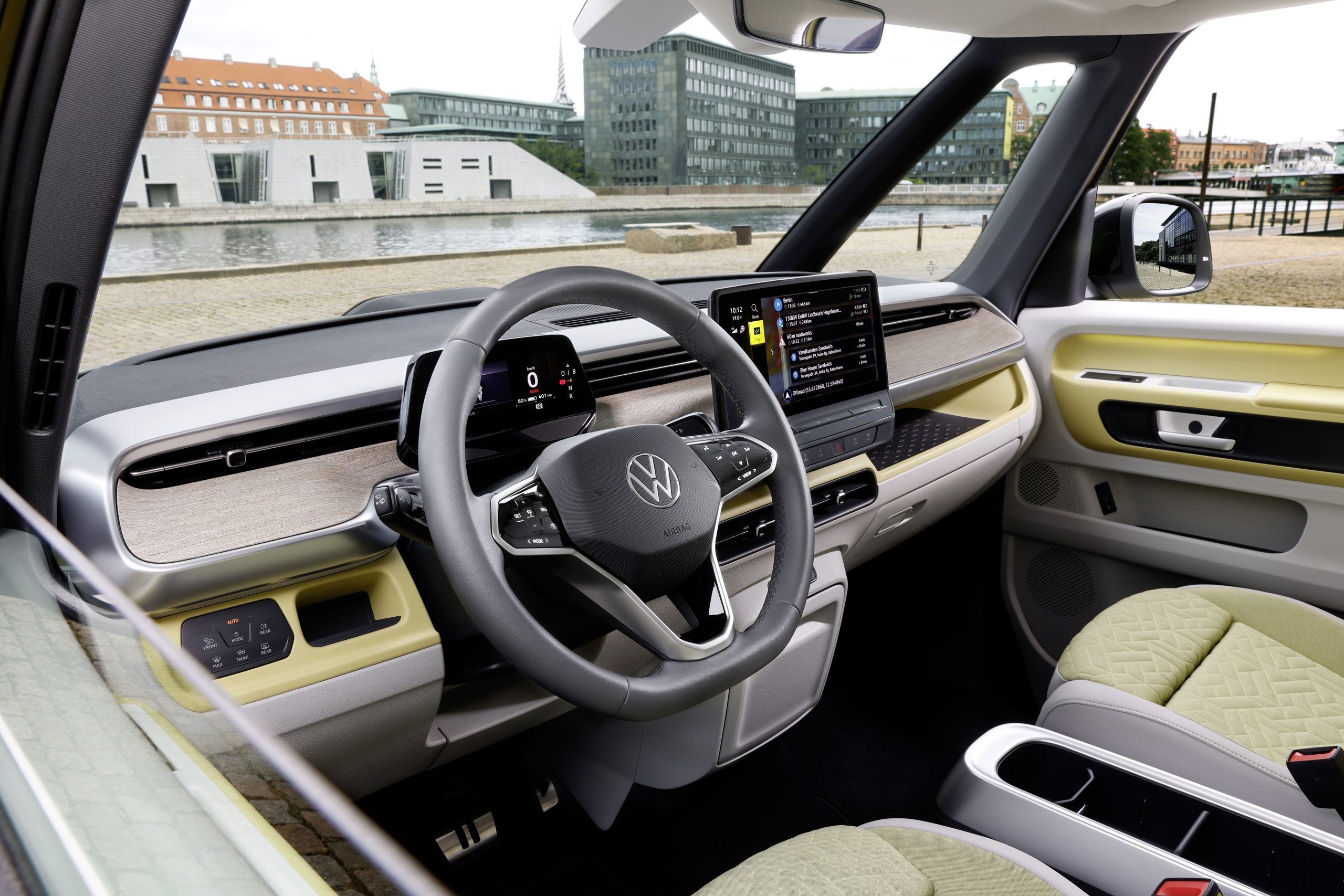
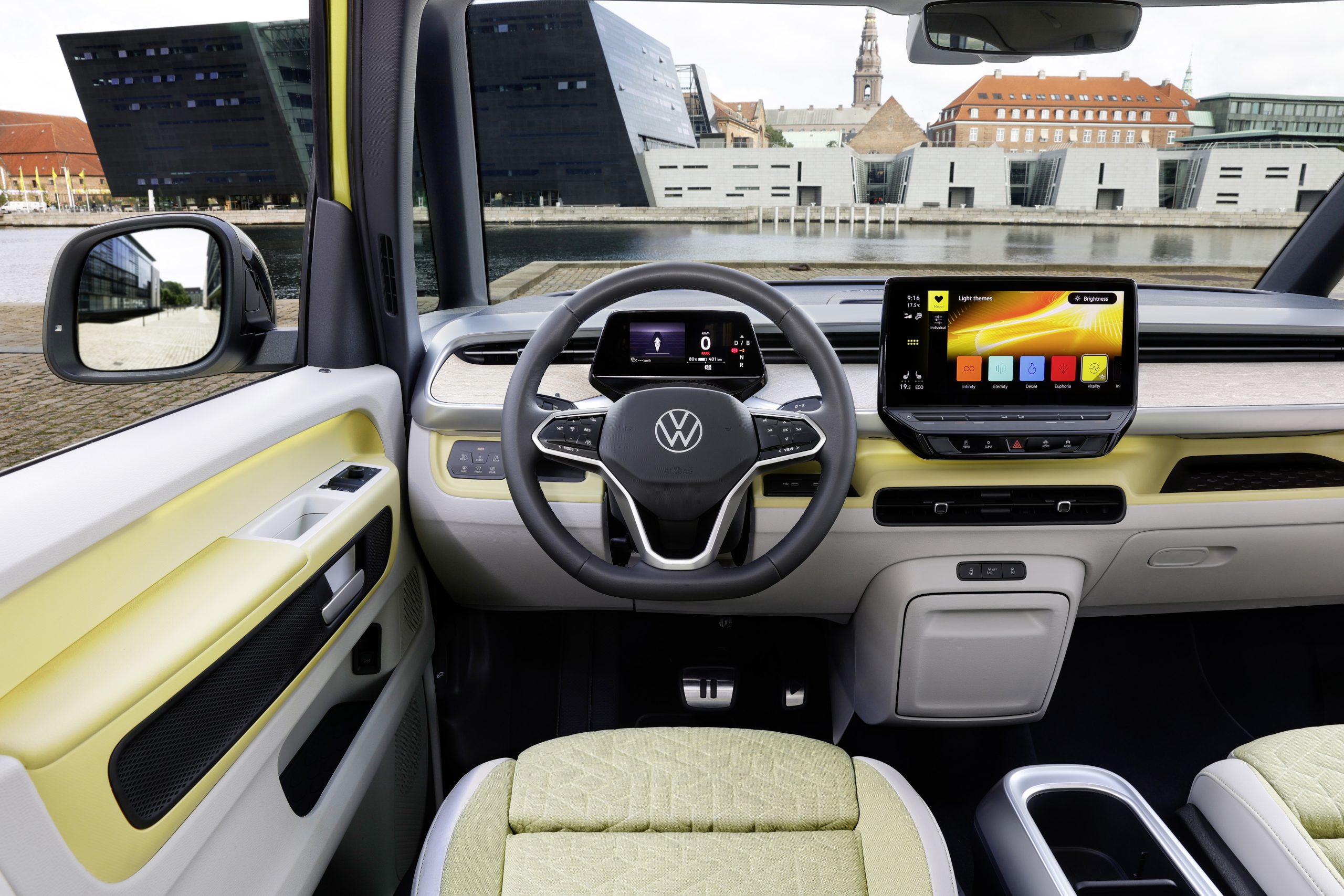
Underpinning the ID Buzz is VW’s MEB rear-drive battery electric structure and this is the largest vehicle on this platform so far. The battery is the largest currently available on the MEB platform, a 77kWh net lithium-ion unit, powering a 201bhp/228lb ft electric motor which drives the rear wheels via a single drop-down gear. It gives a top speed of 90mph with 0-62mph achieved in 10.2sec.
Range is quoted at 258 miles, though driving gently I saw just 208 miles. There’s an 11kW onboard charger and the battery can be charged at up to 170kW on a DC charger. Charge times are 21 minutes for an 80 per cent charge on an appropriately fast DC charger and 10.5 hours on a 7.4kW home wall box.
Efficiency is quoted at 3.35 miles per kilowatt-hour, though in use we could only coax it to 2.9m/kWh. And while ID Buzz emits zero emissions at the tailpipe, generating that electricity means it has well-to-wheels CO2 emissions of 35.2g/km.
Inside the cabin
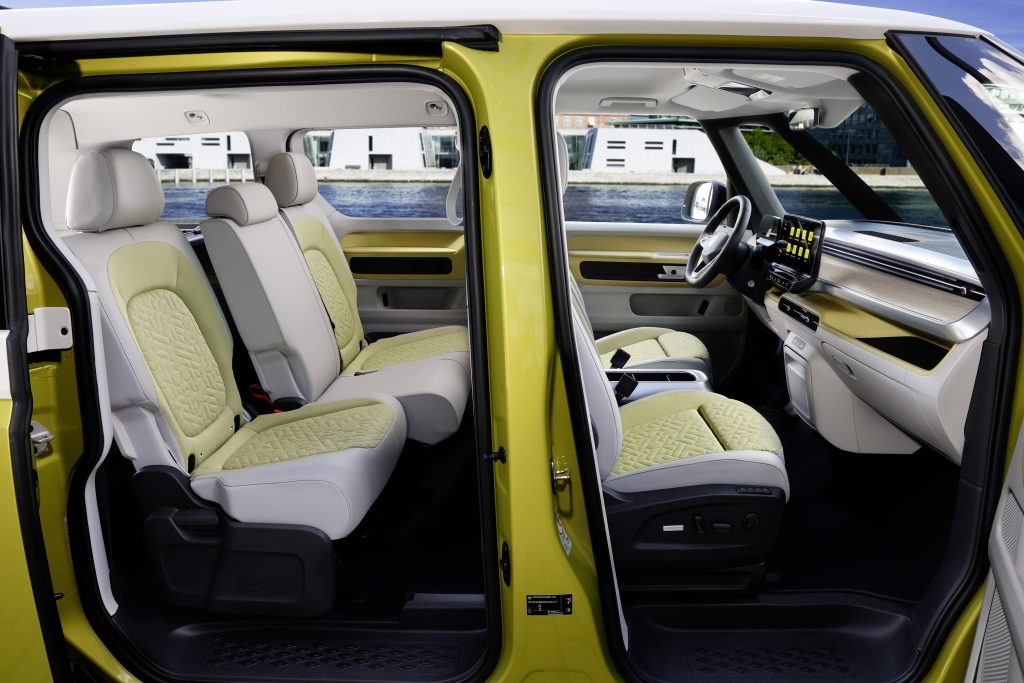
Back to the cabin, where the dash presents a feast of fabulous surfacing and pleasant-to-touch non-leather upholstery. Students of the old models will recognise the ‘wood’ surfacing on the dash from the old Type 2 Bay Window. At the wheel, the old Transporter’s driving position over the front axle is a thing of the past and in some senses, you are so far back from the windscreen it feels like the much-missed Renault Espace.
There’s so much love gone into the cabin, with double height shelving, clever slots for your mobile phone, fold-out and suitably large mug holders, and a flat floor between driver and front-seat passenger which is lovely and reminiscent of the old Type 2.
Not so keen on the small USB C charge slots, much loved by the techies but imply you’re going to throw out all your old charge cables which is far from the peace-‘n-love Hippie vibe of the old Transporter. And while you can get a high luggage space frame to make a complete through bed, it’s a bolt-in feature, which will take a couple of hours to remove – not exactly the stuff of a quick getaway on a tour of Europe.
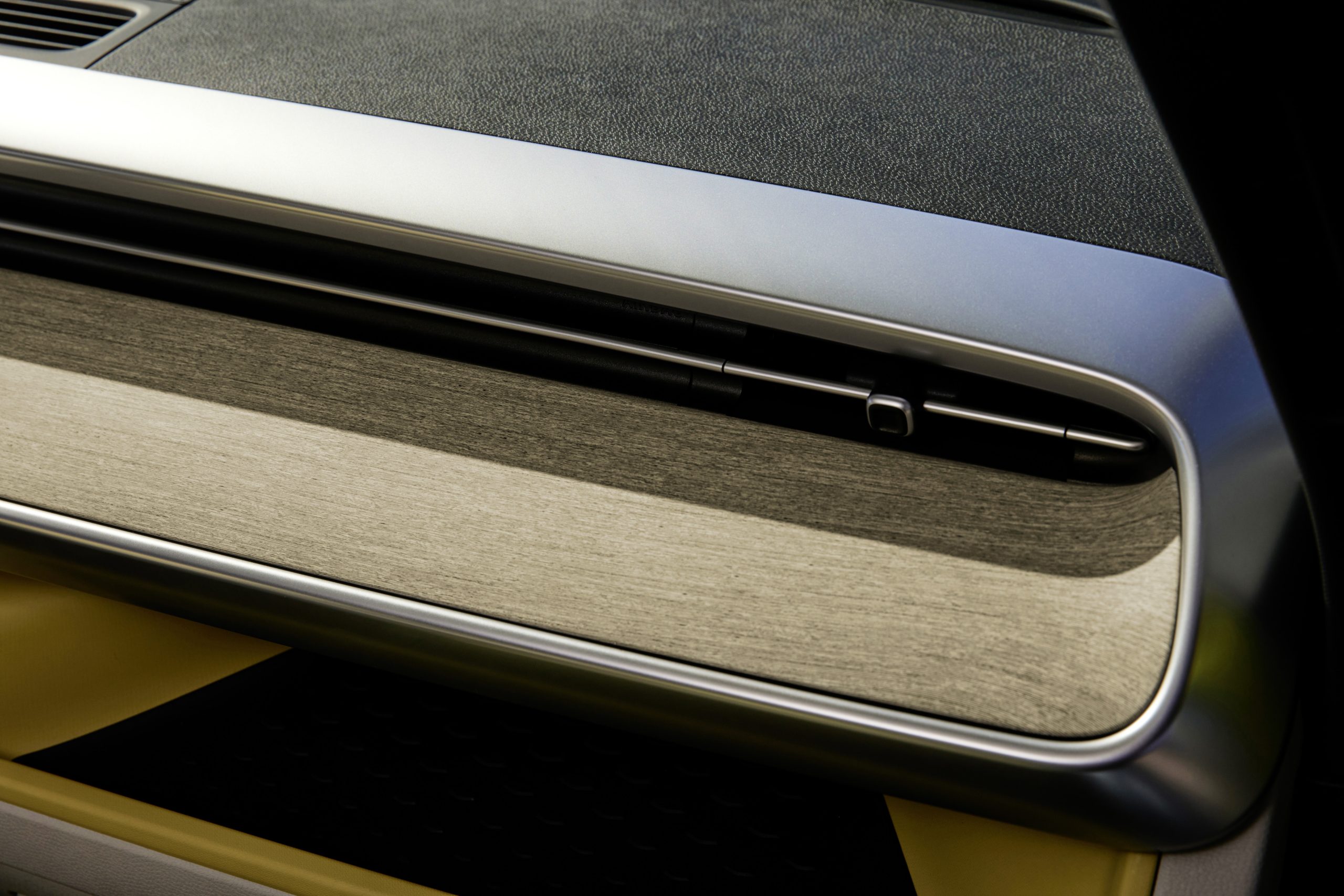
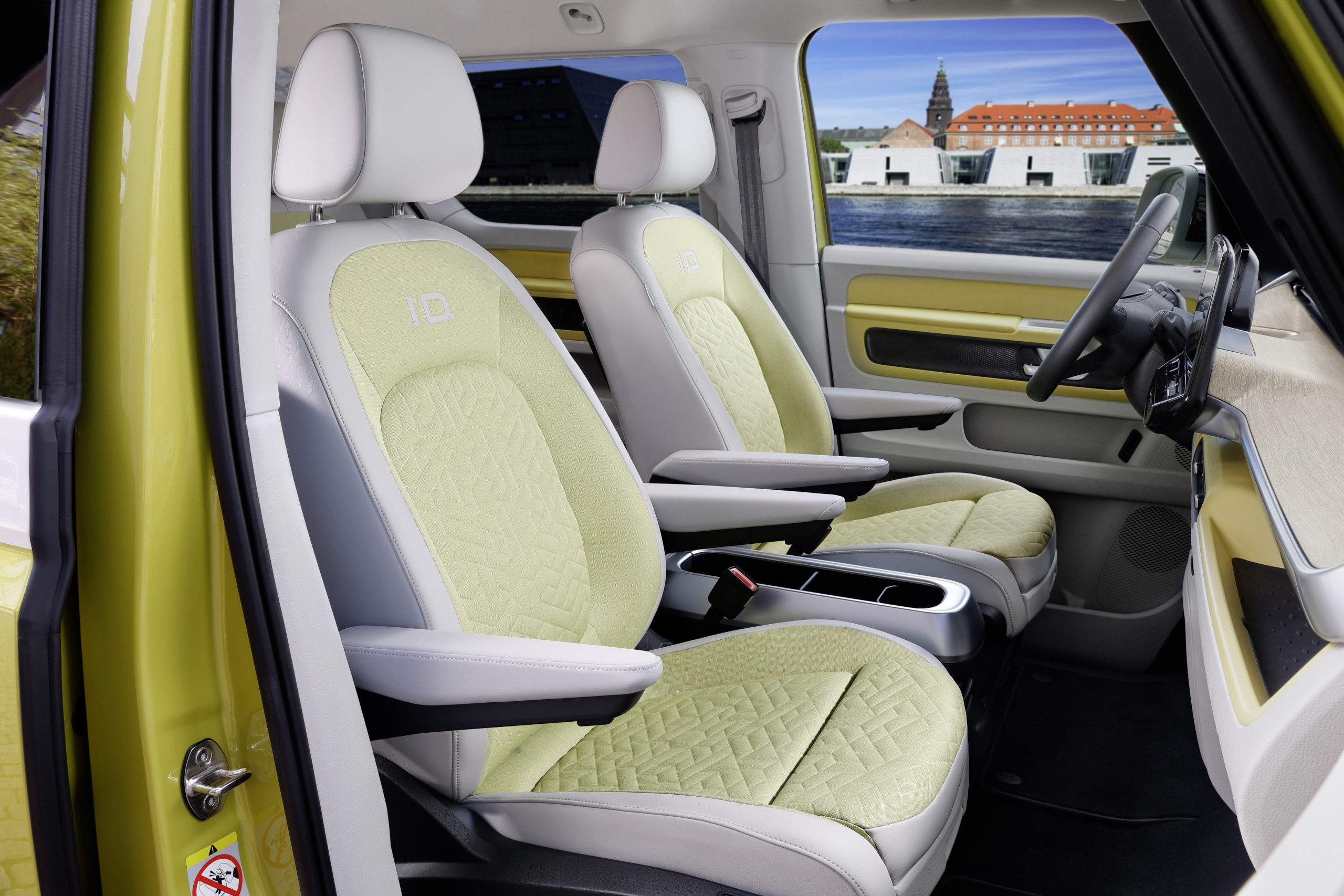
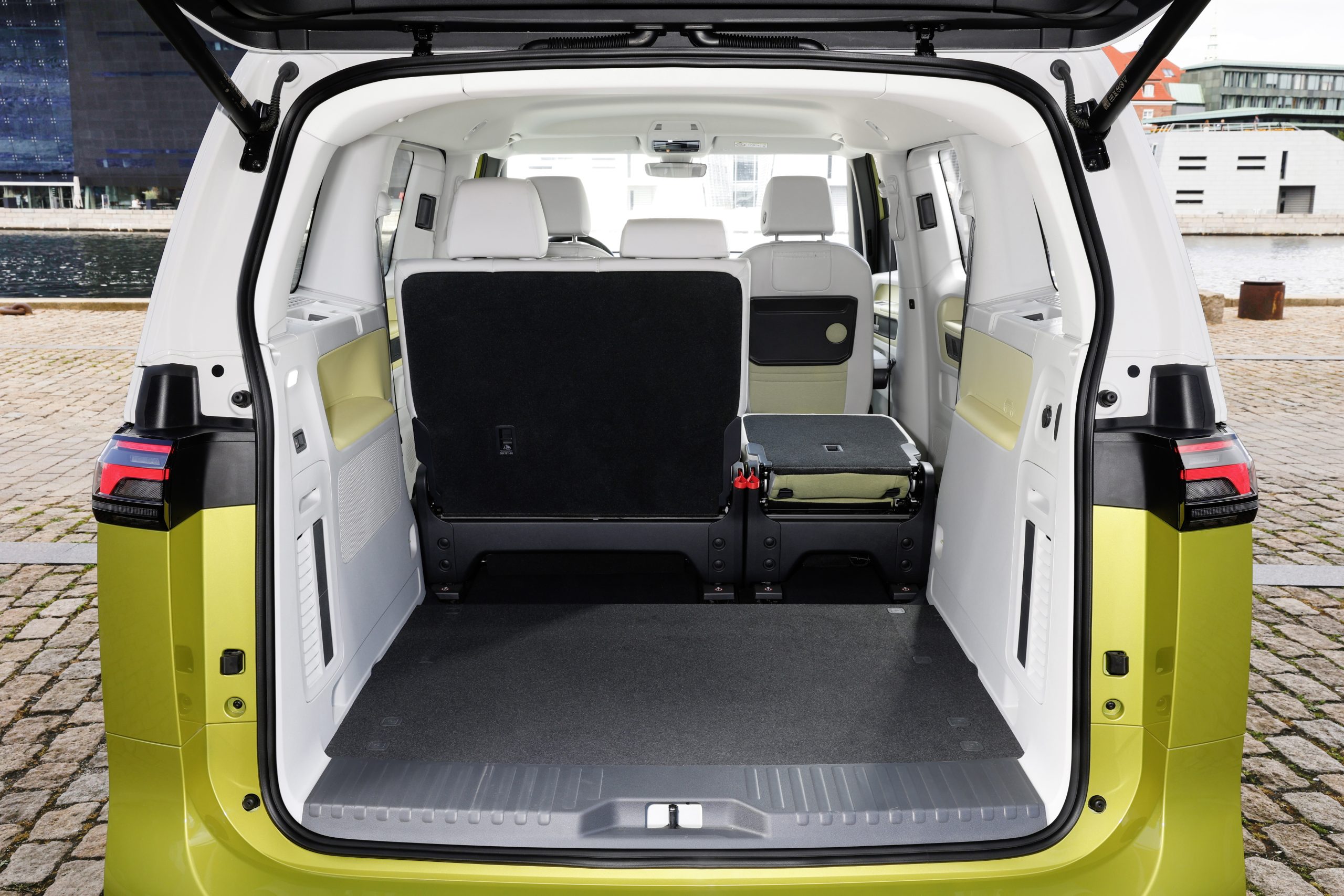
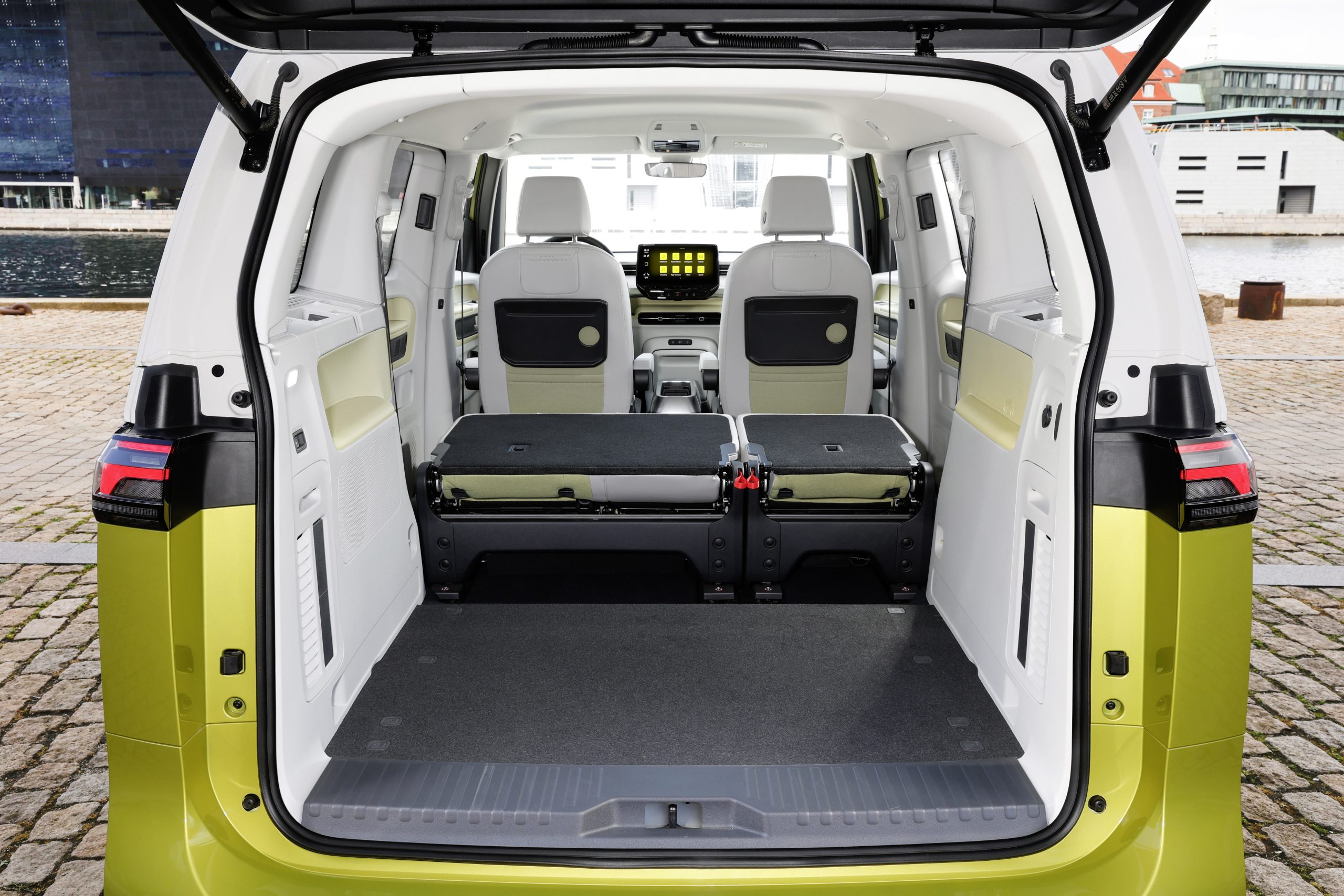
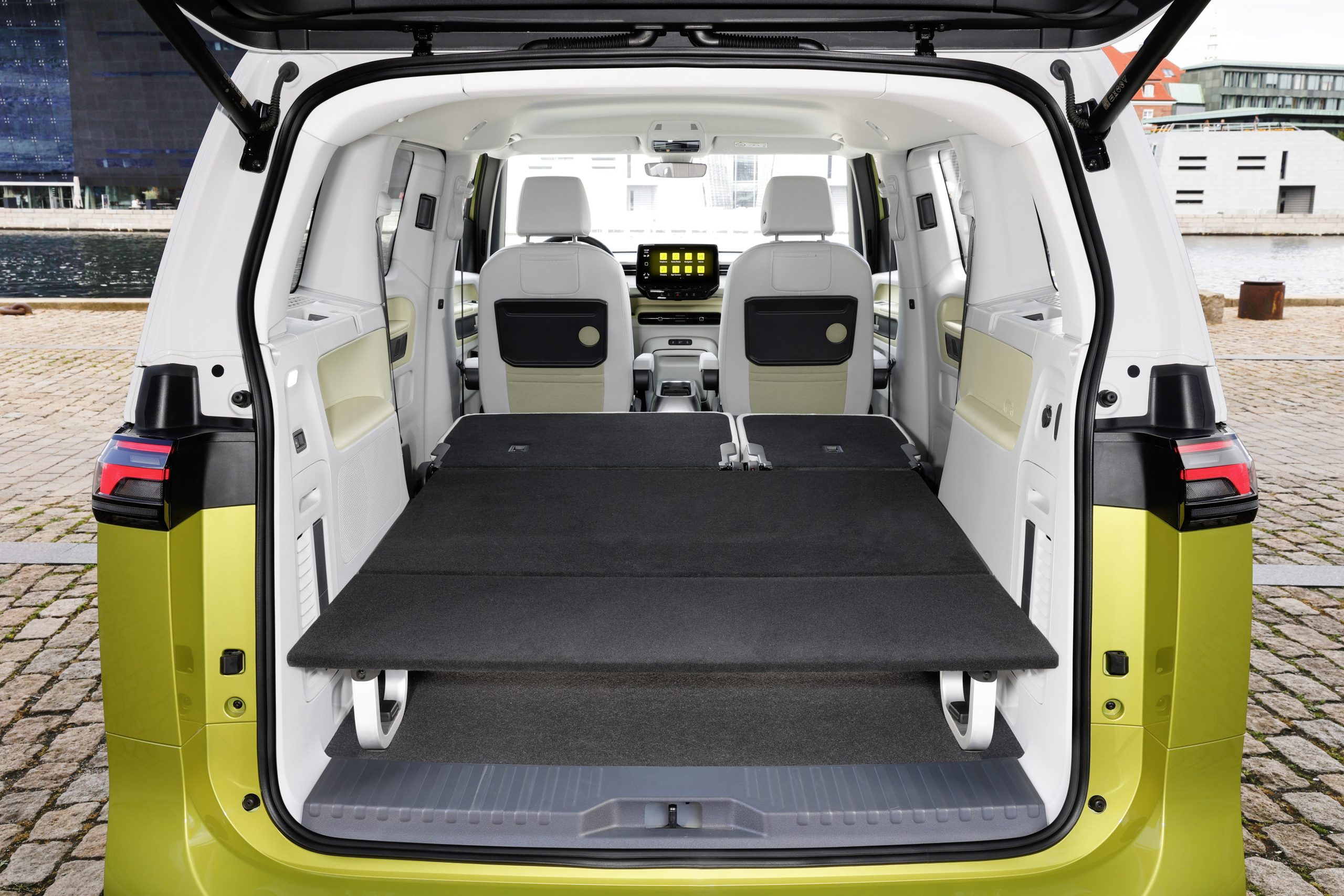
Still, the sliding rear doors shut with that clunky thump of the old vans and the top-hinged tailgate makes a superb rain shelter for wet picnics. You sit almost 900mm off the ground with panoramic views out thanks to the large front screen and quarter lights. The seats are large and comfortable and in the back there’s loads of head and leg room. The wheel at each corner stance and the hefty kerbweight makes for a stable and solid feeling driving experience. While you wouldn’t want to throw the ID Buzz around, I did (so you don’t have to) and can report that it’s safe and trustworthy, with stability systems which cut in gently and a tendency to nose-on understeer if you find yourself careering into a tightening corner on the way to San Jose.
Sadly, it’s not all brilliant and the old bugbear of VW’s Cariad touchscreen systems and software are stuck, like a smelly cat in the middle of the dash. Even changing the heater setting is the work of several key strokes and good luck at night as the temperature and radio volume sliders aren’t illuminated. The system might now be stable with its latest 3.2 software upgrade, but it’s still pretty hopeless – and a subject close to many readers’ hearts, from what we can tell from your feedback.
And I’m sure I didn’t imagine this, but as I climbed into the cabin, the brake pedal wagged up and down in greeting, which was either a charming affectation in the control systems, or notice of trouble ahead.
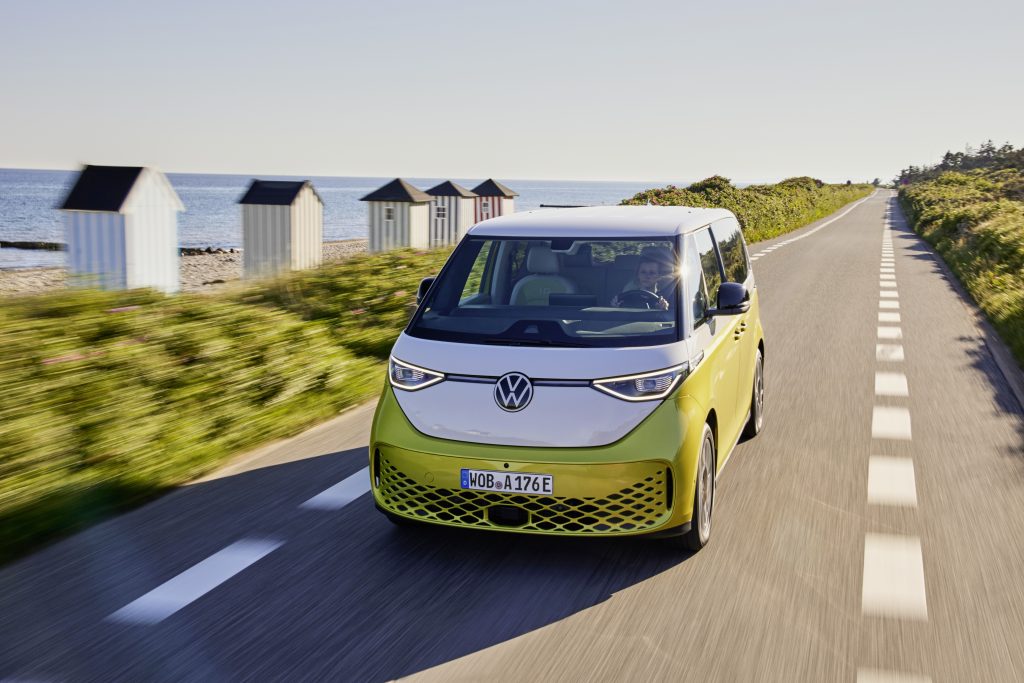
Dynamically it feels quick off the line and powerful, with lots of acceleration at the squeeze of the progressive-feeling accelerator; a feature of all EVs where the motor produces all its torque right from when it first starts to spin. Uncorrupted by driveshafts, the steering is accurate and well weighted with a good on-centre response. VW boasts that the 20-inch (optional) tyres are a full 750mm in diameter and there’s a fair amount of sidewall to turn before the nose changes direction, but on the move, this isn’t a problem.
With four different driving modes, it’s mostly a case of progressively tightening up the steering and accelerator response. You almost always end up in Comfort which is the best compromise of lift off regeneration, accelerator response and steering weight. Those big tyres are quite noisy, even on Denmark’s smooth roads, and they set up a noisy ‘sproing’ over sharp-edge holes and expansion joints.
With MacPherson-strut front and multi-link independent rear suspension, the ID Buzz feels mostly long-legged and comfortable. It’s set up quite softly and the ride quality is smooth even though there’s a fidgety response from the rear at motorway speeds. With, say 200 miles between recharges, with the right fast-charge infrastructure, you could cover serious miles in this van.
And while it’s a big and heavy thing, manoeuvring the ID Buzz is much simpler than you might suppose, partly because it has the basics of good all-round visibility and large door mirrors to go with the panoply of bells, whistles, reversing cameras and warning lines on the screens.
Verdict
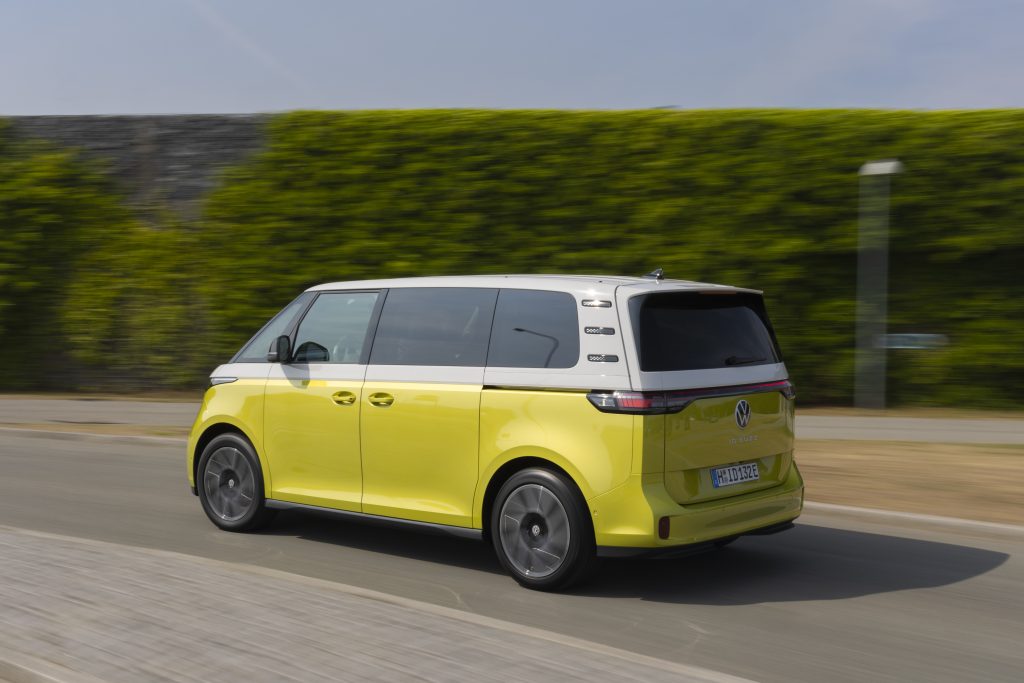
As a commercial proposition, the ID Buzz isn’t going to have much appeal outside the promotional van/florist trades. A conventional three-tonne panel van will carry almost twice the weight of this machine with almost twice the range.
As family transport the ID Buzz needs more seats and or more flexibility. It’s also selling into a market segment which rival manufacturers are fast deserting – Citroën withdrew its C4 Grand Spacetourer from sale this year for example. Yet somehow, and perhaps it’s the history or the long wait, or maybe the care that’s gone in, the ID Buzz gets under your skin and you find yourself at the wheel, thinking of ways in which you could include this big, heavy and expensive vehicle into your life.
For me, this van is a bit like seeing a litter of Newfoundland puppies, you know each one will cost a fortune to own, will come and ‘rescue’ you every time you go swimming and will make you and everything you own smell of wet dog, but… Well, take it from me, ID Buzz is irresistible and if you don’t want to own one, don’t go anywhere near it.
Welcome back Bulli.
2023 Volkswagen ID Buzz specifications
Price: from £57,115 in Life trim, £61,915 in Style trim, as tested in 1st Edition £62,995. Cargo Commercial from £38,125 ex-VAT
On sale: now autumn with first deliveries early 2023
How fast? 90mph, 0-62mph in 10.2sec
How economical? 3.35 miles per kilowatt hour (WLTP Combined), on test 2.9mkWh
Electric range: WLTP Combined, 258miles. On test, 208 miles
Charge times: 21 minutes from 10-80 per cent on a 170kW DC charger, 10.5 hours for a 10-100 per cent charge on a 7.4kW household wallbox
Engine & gearbox: single step-down gear for the motor, rear-wheel drive
Electric powertrain: single AC synchronous motor with 77kWh (net) lithium-ion battery, with 11kW AC charge capability and 170kW DC maximum charge rate
Maximum power/torque: 201bhp/228lb ft
CO2 emissions: 0g/km (tailpipe), 35.2g/km well-to-wheels CO2 equivalent
VED: £0
Warranty: Three years, 60,000 miles
Read more
Best electric cars… for a car enthusiast
What nobody tells you when you buy an electric car
Stars in your eyes: How to buy a classic camper van
















The front looks appear to be swiped from Preston the robot dog from the Wallace and Gromit “A Close Shave” movie. And you get fleeced to buy one.
Not too well thought out, it’s like a half-baked idea that isn’t really anything – certainly not practical. I’ll give it a miss, thanks.
Like the style but would prefer good old gasoline or diesel power here in USA’s west. Trips here are long mileage.
So the peoples car is now out of reach of the ordinary people. Very clever own goal. But our political elite are determined that only a select few will enjoy mobility in the years to come. So why not a name change from Volkswagen to Langenscheidt Wagen.